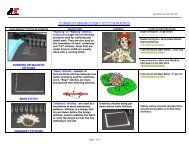Compiled Embroidery Skill Articles
You also want an ePaper? Increase the reach of your titles
YUMPU automatically turns print PDFs into web optimized ePapers that Google loves.
10/28/2016 Getting Started Part 1 Tips For Successful <strong>Embroidery</strong> <strong>Embroidery</strong> Article<br />
even cause holes in the fabric from excessive needle penetrations.<br />
After you determine the right combination of the materials for your project, test again, and if you<br />
find it necessary, try another combination and test yet again until you have found the best<br />
ingredients for the design and the fabric being embroidered. Testing may seem like a<br />
tremendous amount of wasted time and materials, but remember that once you have become<br />
familiar with dif ferent results, these initial repeated tests will save valuable time and cost in the<br />
future. Eventually, one testsew of one design will be all that is necessary for you to recognize<br />
what is needed for a successfully stitched design on various substrates.<br />
Fabrics continue to change formulations, and that causes the embroidery needs of the fabric to<br />
change. Fabrics, as well as stabilizers and threads are continuously invented and old favorites<br />
are upgraded, which can take one by surprise when it’ s discovered that the same design<br />
suddenly produces dif ferent results. So, unless you can af ford a mistake now and then, it’ s best<br />
to always test a design you’ve never stitched to verify quality, or on a fabric or other substrate that<br />
you’ve never embroidered to determine the needs of the substrate. A test will also help you<br />
choose the most complimenting thread colors for the item, thread weight for the best coverage,<br />
types of stabilizers for the strongest foundation, and a needle type and size that stitches without<br />
thread breaks and without damage to the stitches or substrate. If all does not go well in the<br />
testing, don't toss that poorly stitched sample! Bad embroidery is your most valuable teacher .<br />
Down the road you'll thank yourself if you keep those test samples in a notebook or file folder with<br />
all the information about the design, along with the materials used for the successful results of<br />
the final project.<br />
To help you recognize bad embroidery and how to prevent it, see “Getting Started Part 2 –<br />
Troubleshooting ” where you’ll find a list of common problems and solutions.<br />
More From This Author<br />
Dish Soap Bottle Apron By Bonnie Landsberger<br />
Computer Basics for the Machine Embroiderer Part 1 By Bonnie Landsberger<br />
Computer Basics for the Machine Embroiderer Part 2 By Bonnie Landsberger<br />
Share this project:<br />
0 0 0<br />
Meet The Author: Bonnie Landsberger<br />
Bonnie Landsberger has been a crafter and hand embroiderer since childhood and a<br />
machine embroiderer and digitizer since 1986. She was the inhouse head digitizer for a 50<br />
head embroidery shop for 1 1 years and later of fered custom digitizing services and stock<br />
design sales through her web site for Moonlight Design since 1993. She currently also holds<br />
a position as a customer service representative at <strong>Embroidery</strong>Designs.com. Bonnie has won<br />
several awards for digitizing, including a gold medal in the 2002 Digitizing Olympics and<br />
grand prize in all categories & first place for Winter Holidays category in the Stitches<br />
Magazine Great Greeting Card Contest 2003. Her embroidery and digitizing technical<br />
articles can be found in various trade magazines and she is currently a contributing writer and Editorial<br />
Advisory Board Member for Stitches Magazine. You can also find more of her articles online at<br />
<strong>Embroidery</strong>Designs.com and will continue to contribute articles to our Learning Center .<br />
https://www.embroiderydesigns.com/emb_learning/article/1 161/gettingstartedpart1tipsforsuccessfulembroidery .aspx 3/3




